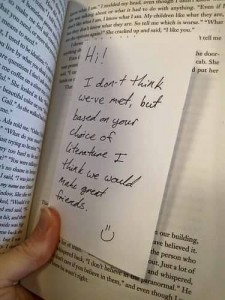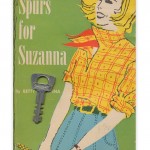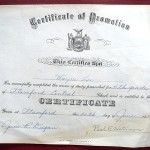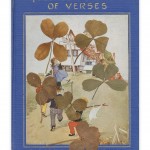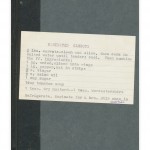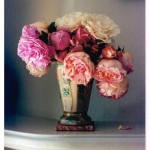Helene Hanff – a love affair
Thanks to Simon at Stuck in A Book, I was reminded of my long-time love affair with Helene Hanff -a lesser-known author who has achieved cult status among bibliophiles. Ms. Hanff was a hard working writer–she wrote essays, television screen plays, magazine articles and industry trade publications –most anything to pay the rent. She was also witty, intelligent and incredibly well read. She put her love of literature, London and New York City into her wonderfully captivating writing. Her books are just plain terrific, based on her own experiences — no fiction necessary here — and none will take you long to read. I believe all are well-worth a permanent place in your personal libraries.
+++++++++++++++++++++++
Ms. Hanff (and yes she would have insisted on ‘Ms’) is most famous for her book 84 Charing Cross Road, which I have read and re-read so many times I had to buy myself a new copy. 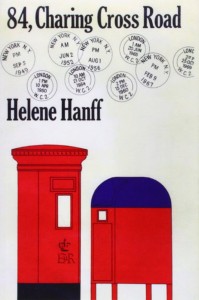 In case you don’t know of this book – it is must reading for any bibliophile. It chronicles the 20-year correspondence between Ms. Hanff and a London antique bookshop located at 84, Charing Cross Road. Ms. Hanff writes to this bookshop seeking various English literature titles in nice affordable volumes. To her delight, she receives not only affordable, but beautifully bound antique editions of her requests — “so fine they embarrass my orange-crate bookshelves”. The letters back and forth over the years are funny, warm and sometimes heartbreaking. The correspondence captures not only the shared love of literature, but family news, dental woes, wartime shortages (she sends the shop food packages during war rationing years) and finding book treasures at English estate sales. The book was made into a 1986 film which did a passable job of portraying the characters and the premise. It stars Anne Bancroft and Anthony Hopkins so you won’t be wasting your time. Remember tingle books? 84, Charing Cross is on my top 10 list.
In case you don’t know of this book – it is must reading for any bibliophile. It chronicles the 20-year correspondence between Ms. Hanff and a London antique bookshop located at 84, Charing Cross Road. Ms. Hanff writes to this bookshop seeking various English literature titles in nice affordable volumes. To her delight, she receives not only affordable, but beautifully bound antique editions of her requests — “so fine they embarrass my orange-crate bookshelves”. The letters back and forth over the years are funny, warm and sometimes heartbreaking. The correspondence captures not only the shared love of literature, but family news, dental woes, wartime shortages (she sends the shop food packages during war rationing years) and finding book treasures at English estate sales. The book was made into a 1986 film which did a passable job of portraying the characters and the premise. It stars Anne Bancroft and Anthony Hopkins so you won’t be wasting your time. Remember tingle books? 84, Charing Cross is on my top 10 list.
+++++++++++++++++++++++
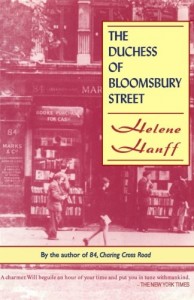 The Duchess of Bloomsbury Street chronicles Ms. Hanff’s experiences in London after the publication of 84, Charing Cross Road. She finally makes her first long overdue trip to London and meets her friends from the bookshop, as well as her fans. Taken completely by surprise, Ms. Hanff and her book are
The Duchess of Bloomsbury Street chronicles Ms. Hanff’s experiences in London after the publication of 84, Charing Cross Road. She finally makes her first long overdue trip to London and meets her friends from the bookshop, as well as her fans. Taken completely by surprise, Ms. Hanff and her book are
celebrities in London. Here she tells of this once-in-a-lifetime trip where she is treated to a whirlwind of introductions, dinners, teas, tours and finally seeing her precious London.
+++++++++++++++++++++
 If you’re going to New York City, live there, or just love the city from afar, you need to find yourself a copy of Letter From New York.
If you’re going to New York City, live there, or just love the city from afar, you need to find yourself a copy of Letter From New York.
From the back cover: From 1978 to 1984, Hanff ( 84 Charing Cross Road ) recorded a five-minute broadcast once a month for the BBC’s Woman’s Hour about her everyday experiences as a resident of New York City.
Here you’ll meet her friends, neighbors and fellow apartment-house dwellers. She describes free concerts, out-of-the-way city parks, her favorite neighborhoods, people and dogs. This is Ms. Hanff’s New York City – sweetly old-fashioned, intimate and never pretentious.
++++++++++++++++++++++
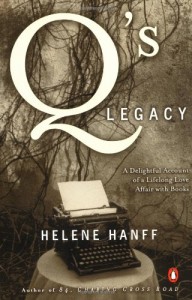 Ms. Hanff was unable to finish her college education, she simply ran out of money. So she decided to educate herself at the public library by working her way through English Literature A to Z. Q’s Legacy chronicles how she discovers Sir Arthur Quiller-Couch –the infamous Cambridge Dean of English Literature and his book “On the Art of Writing”. Reading “Q” spawns a long reading list which now includes English lit classics from Milton, Newman and Walton. Ms. Hanff is unable to find affordable or attractive copies in NYC bookstores. Then one day while reading The Sunday Review of Literature, she spots an advertisement for a bookshop in London …and so the story loops back to the genesis of 84, Charing Cross Road.
Ms. Hanff was unable to finish her college education, she simply ran out of money. So she decided to educate herself at the public library by working her way through English Literature A to Z. Q’s Legacy chronicles how she discovers Sir Arthur Quiller-Couch –the infamous Cambridge Dean of English Literature and his book “On the Art of Writing”. Reading “Q” spawns a long reading list which now includes English lit classics from Milton, Newman and Walton. Ms. Hanff is unable to find affordable or attractive copies in NYC bookstores. Then one day while reading The Sunday Review of Literature, she spots an advertisement for a bookshop in London …and so the story loops back to the genesis of 84, Charing Cross Road.
++++++++++++++++++++++
 Here’s a photo of the bookshop – Marks & Co.
Here’s a photo of the bookshop – Marks & Co.
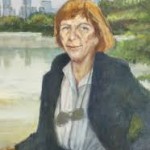 And a portrait of Ms. Hanff – her favorite.
And a portrait of Ms. Hanff – her favorite.
Ms. Hanff passed away in 1997 – poor and without any surviving relatives. Her NY Times obit HERE.
I think that somehow she must know her books are beloved, re-read and cherished by many a book lover.
The Postage Stamp Vegetable Garden by Karen Newcomb
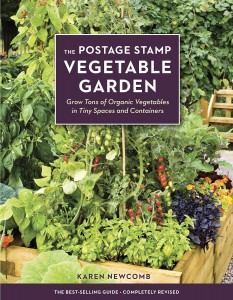 What, you say — a gardening book? Who sits down and reads a gardening book? True confession time, I do. This guide turned out to be ideal for my city-small garden and my raised vegetable growing beds.
What, you say — a gardening book? Who sits down and reads a gardening book? True confession time, I do. This guide turned out to be ideal for my city-small garden and my raised vegetable growing beds.
The book opens with this great passage:
It’s a beautiful day. There’s not a cloud in the sky. The temperature is in the mid-80s. And there you are in your backyard, picking loads of vegetables from your own small garden tucked away in the corner of your property. Tomatoes, onions, corn, beans, you’ve grown them all—in fact, more than you ever dreamed possible from such a small space.
Impossible?
Of course not. That’s exactly what a postage stamp garden is intended to do and what you will learn to do in the next several chapters. The techniques outlined here allow you to double or triple the quantities of vegetables you might normally grow in any given space.
First published 40 years ago, in this newly revised edition, Ms. Newcomb introduces us to a radical style of gardening tailored for “postage stamp” or small space gardens. She advocates planting seeds much closer than recommended on the seed packets, with no neat rows and succession plant so you have crops all year round (depending on your location).
She goes on to explain the history of this technique.
The history of this incredible gardening system began in the 1890s. Outside Paris, a few enterprising Frenchmen began raising crops using a new method they discovered. Over their land they spread an 18-inch layer of manure (plentiful in the day of the horse and buggy) and planted their vegetables so close together in this rich material that the leaves touched one another as the plants grew. Under this carpet of leaves, the ground remained moist, warm, and vigorous. During periods of frost, they set glass jars over the tiny plants to give them an early start. So good were the Frenchmen in devising fresh ways of growing things that they were able to produce nine crops a year. Such was the birth of the French Intensive method of gardening, an early form of what we now call intensive gardening.
The benefits of this technique, besides year-round vegetables, are quite attractive — you need less water (key here in California) and it requires less weeding (hear-hear!). Not to say that postage-stamp gardening doesn’t have it’s challenges – it does — but they are clearly and simply explained in this book.
She makes it easy to understand her concept of “crop stretching” — that is, when succession planting in an area that has frost and winter (poor you) you should alternate your crops – early spring planted crops (spinach) are replaced by later crops (beans). Also, if you’ve just harvested slow-growing crops (broccoli) in late summer you now have a short growing season left, so plant a quick maturing crop such as green onions. If your garden is in a temperate climate (like mine) you can plant the same crops in succession all year long (as with lettuce or spinach). She goes on to explain “intercropping” — planting quick maturing crops between slower maturing crops. You harvest the intercrops before the maturing crops have grown big enough to crowd the smaller plants out. That’s getting double duty out of your postage stamp bed.
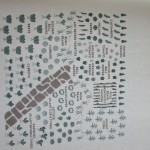 The author has given detailed drawings of sample garden layouts, (sorry for the poor photo) there are several designed to fit a 4×4 bed. Look at all the produce! Click to make larger.
The author has given detailed drawings of sample garden layouts, (sorry for the poor photo) there are several designed to fit a 4×4 bed. Look at all the produce! Click to make larger.
The last half of the book is filled with a vegetable by vegetable guide – Ms. Newcomb recommends heirlooms and gives a cute little postage stamp rating (1 to 4 stamps) to indicate which are best for postage stamp gardens. And each section gives crop stretching advice — “you can follow beans with a planting of cabbage…”
There are additional sections covering: Plants That Like Each Other; Herbs; Companion flowers; Composting and Pest Control.
After reading this book, I felt like a beginning gardener all over again. Turns out I’ve been doing it all wrong — plant my vegetables once (or twice) during the year, always in neat rows, thin the small seedlings, and rejoice over what now appears to be very paltry results.
So, if you have a small garden or don’t want the work of a larger one, this is the book for you.
Now, if you’ll excuse me, I have seeds to plant.
The Life-Changing Magic of Tidying Up by Marie Kondo
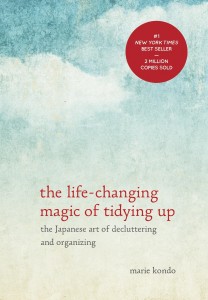 While reading this book, I kept thinking of my sister. From a very young age, she loved organizing and keeping things in order. Her room was always neat as a pin with everything in its place. She would put away the toys while we were still playing with them and loved organizing anything – mom’s kitchen drawers, my jewelery box…anything slightly messy was at risk of little sister putting it in order.
While reading this book, I kept thinking of my sister. From a very young age, she loved organizing and keeping things in order. Her room was always neat as a pin with everything in its place. She would put away the toys while we were still playing with them and loved organizing anything – mom’s kitchen drawers, my jewelery box…anything slightly messy was at risk of little sister putting it in order.
It’s no wonder I was reminded of my sister — Marie Kondo also grew up wanting to organize and tidy things – from her classroom, to her siblings rooms to her parents kitchen and has turned this lifelong passion (obsession?) into a phenomenon in Japan.
The Life-Changing Magic of Tidying Up is a small book – purposely designed to take up very little space. It has a calming clouds and sky image on the cover and easy to hold it in your hands. From the beginning I really warmed to the word “tidy” – such a sweet, old-fashioned word, which seems gentler and more approachable than many other guides and television shows focused on getting organized or how to clean out your awful hoarding mess things. This book is translated from Japanese, so some of the writing is a bit clunky, but nonetheless, I gathered some new ideas, and shook my head at others, while making my way through this book.
She divides people who can’t stay tidy into three types: “Can’t throw it away”, “Can’t put it back”, and “first two combined.” Well, that rang true right off the bat. Ms. Kondo goes on to bust the usual practice of cleaning one closet or one drawer at a time. She advocates cleaning out things (not spaces) in a certain order – and not putting anything back until you’ve finished the process of discarding. This may be practical in tiny Japanese homes, but I wonder how it would work for the multi-storied, many-roomed homes of America. For example, Ms. Kondo wants you to take every single piece of clothing in your home and place it on the floor – the mere thought gave me an instant headache. But it appears that’s the goal — to overwhelm her clients with the staggering amount of clothing they posses and seldom (or never) wear. As a person who changes sizes with regularity (I have three sets of clothes: fit me now, maybe fit me soon, and in my dreams…) this is a very scary proposition.
Storage solutions (sorry Container Store) are poo-pooed as just a method to perpetuate hoarding. OK that does make sense but Ms. Kondo goes too far when keeping a spare button box is discouraged because when a button falls off it is usually time to get rid of the clothing? The question mark is mine. Should we also not keep a sewing box to make repairs?
When it comes to childhood memorabilia and other things from the past – Ms. Kondo makes good sense with this advice; “It is not our memories but the person we have become because of those past experiences that we should treasure. This is the lesson these keepsakes teach us when we sort them. The space in which we live should be for the person we are becoming now, not for the person we were in the past.” Whoa — I had to write that down.
This book does point out that mess is often about unhappiness and that tidying can bring happiness – OK that, too is true. I always feel better when I’ve cleared out a drawer or a closet. But I’m not sure it’s linked to the spirituality that Ms. Kondo promises. This little volume is packed with some pretty “out-there” suggestions – greet your home when you enter it. Say thank you to items before you put them away. Folding clothes with an open palm transmits positive energy. Do my clothes really need energy of any sort?
Stockpiling is obviously discouraged (sorry Costco, Sam’s Club) and once again I thought of my sister – when she uses one can of tomato sauce, she replaces it with one can of tomato sauce. No impulsive buy 3 get one free sales for her. Even though my house is tiny, I have a pantry. I live in fear of running out of chicken broth. I just looked and currently have three cartons.
The book advocates only keeping things that truly give you joy – which I understand, but what about my the pragmatic things in your life? My food processor is ugly, it takes up space in my cupboard and it doesn’t actually bring me said “joy” –but when I need it – wow is it practical. Ms. Kondo lost me with her advice on clearing out books (natch), She advocates taking each book off the shelf and deciding if the book in your hands brings you joy before deciding whether to keep it. She feels books left on the shelves have a certain inertia and tend to stay there. Has she never wanted something to read, not sure what, and found the perfect book on your own shelf…now that’s joy.
I fear her OCD (she empties her purse every single night, placing each of the contents in its own little place, and puts her watch into a little box every night so it can “rest” overnight) — seeps into her advice, loosing credibility for the real world and the rest of us. I agree with other reviewers that the book only talks of throwing things away rather than donating, recycling or selling items you’re discarding. Does Japan have a bottomless landfill?
I shook my head over the impracticality of much of her advice. Ms. Kondo is obviously a single woman and able to keep everything she owns exactly in place …obviously she doesn’t live with messy children or a “I’ll find a use for this someday” husband. Her business is thriving in Japan and this book is a best-seller…but I must admit I only got a few good pointers from the book and overall I found it preachy and overly-simplistic. So do as I did – get this book from your library – gather what you will from reading it – and then return to your library — no need to add this book to your clutter.
The Most of Nora Ephron
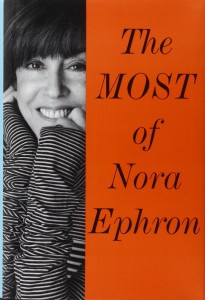 From The New York Times Book Review “Nora Ephron was the person everybody wanted to hang out with, in part because she was funny and charming but more critically because she made the people she was with feel funny and charming . . . She was the one who listened and then finally tossed in the one fabulous line that brought everything together. Her best writing was exactly the same . . . It takes a particular combination of winning voice and brutal candor, of intimacy and objectivity, to turn what happens to you into a story that means something to the wider world . . . The Most of Nora Ephron gives her fans a chance to rummage through her desk . . . This is the kind of collection meant for snacking . . . She would want readers to meander, sampling things they had never tried or bits that look especially tasty. But I was surprised by how satisfying the big chunks are.”
From The New York Times Book Review “Nora Ephron was the person everybody wanted to hang out with, in part because she was funny and charming but more critically because she made the people she was with feel funny and charming . . . She was the one who listened and then finally tossed in the one fabulous line that brought everything together. Her best writing was exactly the same . . . It takes a particular combination of winning voice and brutal candor, of intimacy and objectivity, to turn what happens to you into a story that means something to the wider world . . . The Most of Nora Ephron gives her fans a chance to rummage through her desk . . . This is the kind of collection meant for snacking . . . She would want readers to meander, sampling things they had never tried or bits that look especially tasty. But I was surprised by how satisfying the big chunks are.”
Nora Ephron died in June of 2012 and her obituary, also by the New York Times is beautifully written HERE
I can’t top either the NY Times review or their obituary, so please bear with me while I uncritically just gush – I love Nora Ephron – always have, always will.
You know the question — which people dead or alive would make up your perfect dinner party. Well Nora was, and is, always on my list. I’ve read almost everything she wrote and adore her films – Sleepless in Seattle , You’ve got Mail and Julie and Julia, just to name a few…
A friend gave me this hefty volume of almost everything Nora Ephron wrote. It’s been next to my reading chair ever since and I’ve been making my way through it little by little.
The volume divides her work by her professions:
The Journalist: Nora’s early essays from the 1970’s and most of which I’d never read before. Her essay Journalism: A Love Story overflows with her delight of landing a position at the Post and the legends she encountered — never jaded or blase – she had found her true passion and was greatly in awe of the profession. The Palm Beach Social Pictorial is a hysterical send-up of a Palm Beach newspaper for which her friend, Liz Smith often wrote a column. Nora recounts sections from the paper – the goings-on-about town, the ladies who lunch wearing diamonds with their tennis whites, the older women with their younger men and then this – “Bill Carter (now UN ambassador to UNICEF) proved he really does love children by bringing his latest airline hostess”.
The Advocate: Includes her inspirational commencement address to Wellesley class of 1996 – contrasting both the sea changes and the backward progression of women’s roles since she attended in 1962. Imploring the class to break the rules and make some trouble on behalf of all women.
The Profiler: It’s well worth reading each and every one of these essays — her intimate and often colorful portrayals of the significant women of her age, including Dorothy Parker, Jan Morris, Helen Gurley Brown and Julie Nixon Eisenhower. Her parody of The Girl with the Dragon Tattoo called Lisbeth Salander, The Girl Who Fixed the Umlaut has been passed around among readers of the best-selling series. If you’ve read any of Stieg Larsson series, you should read the essay HERE (Warning, like Larsson’s books – contains graphic language.)
The Novelist, The Playwright, The Screenwriter: Here this gargantuan book includes the full novel Heartburn, the play Lucky Man and the screenplay When Harry Met Sally. I’ve already read Heartburn, dipped into Lucky Man but could not stick with it and skipped When Harry Met Sally (I couldn’t read it without replaying the film in my head).
The Foodie: Nora appreciated food, the New York restaurant scene and the foodies in her life, but here she has to poke fun at it all. Some of her most giggle-worthy essays are in this section. She reports straight-faced about the Pillsbury Bake Off — which makes the essay all the more funny and she rants about the absurdity of egg-white omelettes.
The Blogger: Nora (see I feel like I can call her just Nora) was a blogger during the Bush/Cheney administration and her blog gave her full license to rant – with humor and political incorrectness. Read it and cringe –or weep depending upon your politics. Her blog also gave her license to finally reveal and confirm the identity of Deep Throat from the Watergate investigation…she self-righteously points out that she knew it all along, but wisely kept her mouth shut.
Personal: This final section is the best with pieces taken from her other (much more lift-able) books of essays – I Feel Bad About My Neck and I Remember Nothing. This section also includes my favorite essay Nora ever produced – called On Rapture, an essay about reading. You can read it HERE on Oprah.com I had this essay ripped out of Oprah’s magazine where it first appeared, and in my reading nook for years. In On Rapture Nora recounts her delight reading The Amazing Adventures of Kavalier & Clay by Michal Chabon which I promptly read and was (like Nora) simply transported away – please add it to your reading list. Another essay in this section, Considering the Alternative talks about death, dying and the loss of her dear friend. “I want to talk to her. I want to have lunch with her. I want her to give me a book she just read and loved. She is my phantom limb, and I can’t believe I’m here without her.” True confession time – a few tears slipped down my cheeks.
The final two essays are lump-in-your-throat reading, as by this time Nora (and only one or two others) knew of her diagnosis.
What I Won’t Miss: Dry skin, Email, Bras, Fox (News), Small Print
What I Will Miss: Waffles, The concept of Waffles, Fireworks, Laughs, My Kids, Dinner with Friends, Pie
I totally enjoyed this book and am very grateful to have it. (The full length novel, screenplay, and play notwithstanding). The Most of Nora Ephron will have its hefty place on my shelves, for awhile at least. I may need to go back and re-read certain essays. Also, I know I’ll be talking with someone and say – “oh but Nora wrote the best essay on that…here let me get it for you”. That’s Nora for you.
If you want the collection of most everything Nora has written and you’ve been lifting weights – then this is the book for you. Otherwise go for her books of her most recent essays I Feel Bad About My Neck and I Remember Nothing.
OK I’m done gushing – I just love Nora Ephron and she would have a place of honor at my imaginary dinner party…along with
Ruth Reichel, John Adams, Julia Child, Eddie Izzard, Deborah Cavendish (the Duchess of Devonshire), Dame Judi Dench, Sir John Gielgud, Paula Poundstone, Molly Ivins, Maryalice Fischer, Pat Conroy, Maggie Smith, Jane Heath Donohue…and others.
My cast of characters may change over time, but Nora will always be on the list.
Lost Between The Pages
Photo courtesy of Toad Hall Bookstore
As many of you know I volunteer with THIS organization where they allow me to work in their Readers Bookstores, shelving books, helping customers, working the register – all pure bliss for me. When working with used books, it seems there is an unwritten rule that any items left in the books stay with the books. But that doesn’t stop us from examining and commenting on what we find.
There is the expected – bookmarks, airline boarding passes, the store receipt from where the book was purchased and shopping lists. Then there are photographs – seems dangerous to me to use a favorite photo as a bookmark – only to accidentally leave it in the book when you pass it on. Handwritten letters or postcards from loved ones – the voyeur in me always reads them before putting them back in the book with a sad sigh as I’m sure the owner never meant to leave them behind.
It’s a fascinating subject – things left behind in books –so I must introduce you to Michale Popek who has a wonderful blog aptly named Forgotten Bookmarks. I’ve been a fan since 2007 when Mr. Popek, a bookseller, started his blog to showcase the oddities he found in books.
As his blog header states: “I’m a used and rare bookseller. I buy books from people every day. These are the personal, funny, and weird things I find in those books.”
The blog turned into the book in 2011
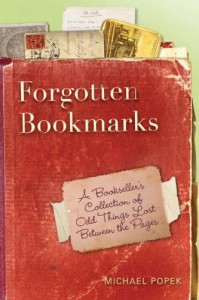 Forgotten Bookmarks by Michael Popek
Forgotten Bookmarks by Michael Popek
From the back cover: It’s happened to all of us: we’re reading a book, something interrupts us, and we grab the closest thing at hand to mark our spot. It could be a train ticket, a letter, an advertisement, a photograph, or a four-leaf clover. Eventually the book finds its way into the world-a library, a flea market, other people’s bookshelves, or to a used bookstore. But what becomes of those forgotten bookmarks? What stories could they tell?
A friend gave me a copy of this book as soon as it was released, knowing my penchant for used books and used bookstores — just in time too, because I was about to buy a copy for myself.
The book has full color plates of all the items and is categorized into sections:
- Photographs
- Letters, Cards and Correspondence
- Notes, Poems, Lists and Other Written Ephemera
- Receipts, Invoices, Advertising, and other Official Documents
- The Old Curiosity Shop: From Four-Leaf Clovers to Razor Blades.
Here’s just a sampling from his collection on the blog — click to view larger or better yet go to his blog HERE:
What stories these items have to tell. Is that a teenage girl’s diary key? Imagine a beautiful summer day, the children playing, collecting four leaf clovers and then carefully pressing them into a favorite story book. The last photo above is significant, because Mr. Popek has collected so many recipes that he now has a new book:
![180993415[2]](https://www.bookbarmy.com/wp-content/uploads/2015/03/1809934152-200x300.jpg) Forgotten Recipes By Michael Popek
Forgotten Recipes By Michael Popek
A Booksellers Collection of Curious and Wonderful Recipes Forgotten between the Pages.
One of the best things about either the blog or the books is that Mr. Popek has taken the time to transcribe the letters, recipes and other hard-to-read, hand scrawled materials.
So go have fun on his blog or better yet buy his book(s). You’ll enjoy leafing through, imaging the stories behind each “forgotten” bookmark while you take a break from reading. Just as I am doing while I strive to finish THIS BOOK– a very mixed review to follow.
- Have you even lost anything by leaving it in a book?
- What’s the most interesting thing you’ve found in book?
How I Became a Rose Nerd
I was in Safeway, watching hapless men buy long-stemmed red roses for Valentines Day and silently cried “oh you poor guys, those aren’t real roses!”. But 20 years ago, that too was all I knew of roses. Then my mother gave me this little book and it changed everything. Therefore, the subtitle for this post is: It was all my mother’s fault.
 Once upon a time—before the 1860s—people loved old roses like “Baronne Prevost” “Marchionesse of Lorne,” or “Autumn Damask.” These were roses from the garden, richly scented and overflowing with petals. The trouble was once cut and arranged, the beautiful blossoms only lasted a few days — oh but those few days were a visual and perfumed delight. The artists of the time captured such lush rose arrangements even including their fallen petals.
Once upon a time—before the 1860s—people loved old roses like “Baronne Prevost” “Marchionesse of Lorne,” or “Autumn Damask.” These were roses from the garden, richly scented and overflowing with petals. The trouble was once cut and arranged, the beautiful blossoms only lasted a few days — oh but those few days were a visual and perfumed delight. The artists of the time captured such lush rose arrangements even including their fallen petals.
Then some enterprising nursery folks developed the hybrid tea roses (as in those long stemmed red roses at Safeway). These were easier to arrange (fewer thorns), more dramatic (brighter colors), and longer lasting (an arrangement of store-bought tea roses can last up to two weeks). But the saddest part of these new roses, was they had no scent…highly scented roses tended to be more delicate and less sturdy. So they bred the scent right out of these florist favorites. As so the old roses were all but forgotten.
But as In Search of Lost Roses tell us, these gently-hued, richly perfumed old roses made a comeback, thanks to the efforts of a crew of eccentric characters who rescued them from back alleys, ramshackle cottages, and overgrown graveyards across the country. Mr. Christopher recounts the fascinating stories of the old roses—how they were created and named—and the unforgettable people who saved them. We go from Texas to California to the American South to visit the interesting people who love and search for lost roses. It’s pure adventure as we join a group of “rose rustlers” as they sneak into secreted walled gardens, tramp through abandoned lots, climb over fences and visit forgotten cemeteries all in an effort to take and propagate cuttings from these old roses.
We meet the famous British old rose experts (Graham Thomas and David Austin*) and learn of how American pioneer wives brought rose cuttings from their far-away homes, lovingly keeping them damp during the journey. Even the rose nomenclature is full of politics, lost loves and secrets. Mr. Christopher’s discussion of rose genetics and propagation was fascinating – well at least to this rose geek. “Heritage’ or ‘heirloom’ roses are defined as those bred before 1867. No two old roses are alike – they come in all shapes – flattened, quartered petal formation, cupped or “overblown as a crinoline petticoat”. I devoured this book, taking notes, and reading bits aloud to my husband who just stared at me quizzically.
Turns out a major hub of old rose fanatics is here out west, where old roses came out with the Gold Rush and were planted around the miners shack doorways, in parks and at loved ones gravesides. When I closed the book I had a list and my mission was clear must — have — these —roses.
My first trip was to the Celebration of Old Roses just across the Bay.
 I stopped short, here was a huge room filled with old roses of every color, size, type — and readers — the scent was intoxicating – my idea of heaven on earth. Every rose was identified and categorized — China, Moss, Portland — (I could go on but I’ll save you the yawns). I took notes, talked to growers, got advice for my garden (ocean facing, high winds -not great for most roses but with these hardy old roses, I had a chance), and bought my first old rose bush Monsieur Tiller. I met the celebrities of the old rose world – Miriam Wilkins and the infamous Barbara Worl invited me to visit her garden in Palo Alto during the coming month. I came home happy, exhausted and full of plans. My poor husband quietly mentioned, “but I thought we have a drought resistant garden, roses need a lot of water you know”…I turned a deaf ear and secretly vowed to take shorter showers.
I stopped short, here was a huge room filled with old roses of every color, size, type — and readers — the scent was intoxicating – my idea of heaven on earth. Every rose was identified and categorized — China, Moss, Portland — (I could go on but I’ll save you the yawns). I took notes, talked to growers, got advice for my garden (ocean facing, high winds -not great for most roses but with these hardy old roses, I had a chance), and bought my first old rose bush Monsieur Tiller. I met the celebrities of the old rose world – Miriam Wilkins and the infamous Barbara Worl invited me to visit her garden in Palo Alto during the coming month. I came home happy, exhausted and full of plans. My poor husband quietly mentioned, “but I thought we have a drought resistant garden, roses need a lot of water you know”…I turned a deaf ear and secretly vowed to take shorter showers.
My next trip, suggested by Mr. Christopher’s book was here.
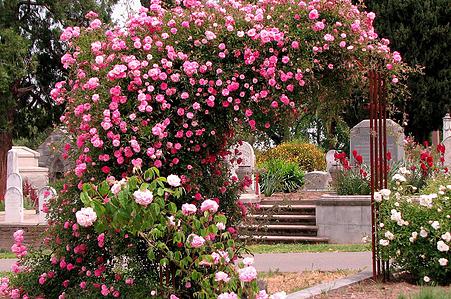 The Sacramento Historic City Center Cemetery. Leaving home at the crack of dawn (not my finest hour), I joined a rose tour of the cemetery during which we were allowed to take a few cuttings. Then a workshop on starting roses from these cuttings -their technique uses zip-lock bags with soil, proper number of days closed and open, then you monitor the root growth …wow sorry — I started to geek-out there.
The Sacramento Historic City Center Cemetery. Leaving home at the crack of dawn (not my finest hour), I joined a rose tour of the cemetery during which we were allowed to take a few cuttings. Then a workshop on starting roses from these cuttings -their technique uses zip-lock bags with soil, proper number of days closed and open, then you monitor the root growth …wow sorry — I started to geek-out there.
Soon I was happily starting roses from cuttings “obtained” on our trips. Click on photos to make larger
A climbing rose from an ocean front lodge in Mendocino 
 A ‘found rose’ from a roadside in Croatia.
A ‘found rose’ from a roadside in Croatia.
 I have many David Austin Roses – here’s one of my favorites – James Galway
I have many David Austin Roses – here’s one of my favorites – James Galway
And like all rose nerds enthusiasts, I mess around for hours arranging my cut roses and then walking by just to smell and admire them.
And so the tale is told, this is the little book that started it all 20 years ago. Both the back and front gardens boast old garden roses and the deck has potted roses struck from cuttings I’ve rustled.
My name is Book Barmy and I’m a rose nerd.
But all geekiness aside, I dare you to read In Search of Lost Roses and not come away wanting at least one old rose for your garden.
Warning, I have another rose book to share with you at a later date — now that will keep you coming back.
* David Austin has developed a modern collection of old garden roses which are disease resistant, repeat blooming and have divine scents. I have many of his lovely roses. For some idea of their beauty click HERE


